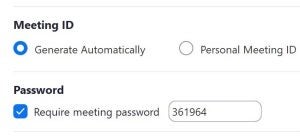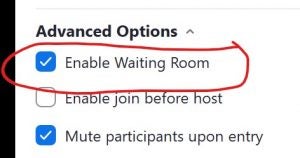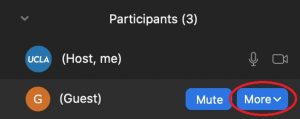As we all navigate a global pandemic and move to online teaching, BruinX has compiled resources to make that transition a little easier. Our efforts as educators and scholars have to include deliberate movements toward creating a more equitable, inclusive, and diverse campus—virtually and in person. We all have a responsibility to do our part in building equity, and this syllabus will help show you how to translate that responsibility into action.
Frequently Asked Questions (FAQ)
This section outlines common questions among faculty and guidance on how to best address certain difficult topics.
I have been called out for microaggressive behavior, now what do I do?
There is a great HBR article on what to do when you’ve been called out on microaggressive behavior. Spoiler alert: Apologize and modify your behavior moving forward.
Do you have more information about remote teaching and other teaching-related innovations?
Yes, absolutely! There are endless and invaluable resources made available by UCLA’s Center for Education Innovation and Teaching in the Sciences (CEILS). Check them out at the following links:
- CEILS Main Page
- CEILS Events
- Center for the Advancement of Teaching: Keep Teaching – Pedagogy (Homepage)
- Center for the Advancement of Teaching: Keep Teaching – Pedagogy (In Response to Racial Trauma)
I want to learn more about racism, implicit bias, and anti-racism; where do I go, what do I do?
That’s a great start! Please check out the wonderfully helpful anti-racism discussion groups held on campus on Fridays 4-5 pm. Here, folks come together with faculty, staff, and lecturers, check it out! Come as often as you’d like, just RSVP via their online form first.
BruinX also has a series of videos available that can help you on your journey. We always keep adding to them, so check back in regularly. Check them out on our YouTube channel.
How do I balance academic freedom and racial sensitivity? How do I discuss controversial topics in a highly polarized election season?
We strongly recommend providing a heads-up or trigger warnings, particularly with respect to racially charged and otherwise potentially traumatic language, images, and/or video materials in your class or syllabus. You can also familiarize yourself with the principles of the First Amendment within the classroom setting and with classroom management principles, including recording and trespassers in the classroom.
How can I learn to be a better ally to members of the LGBTQ community?
That important question is the first step. Now go on over to the wonderful folks at UCLA’s LGBTQ Resource Center. They have several trainings year round, and can help point you in the right direction.
I experienced or witnessed something that seems like discrimination or sexual harassment. What do I do now?
We are sorry this happened. Please be reminded that as faculty, you have a duty to report these incidents to the EDI office. Please reach the Discrimination Prevention Office at dpo@equity.ucla.edu or Title IX (gender discrimination and sexual harassment) at TitleIX@conet.ucla.edu. If you’re not sure who to contact, also feel free to send an email to welisten@equity.ucla.edu and we will point you in the right direction. There are no wrong doors!
What are my responsibilities to make reasonable accommodations for people with disabilities?
An important step toward a more inclusive campus is to make education accessible to our Bruins with disabilities. You can find everything you need to know related to accessible education in the UCLA Center for Accessible Education Faculty Handbook (see p. 12 for accommodation instructions for faculty). For a quick glance, you can check this one-pager called UCLA Center for Accessible Education Faculty Information. If you have questions about how to view your student’s accommodation letter, check out these instructions: How to View Accommodation Letters for you Students.
What resources can I offer to students with a disability now that we’re doing more virtual teaching?
That’s a great questions and we’re happy to inform you that UCLA offers several sources of technological support to students with disabilities free of charge. You can find them via the UCLA Center for Accessible Education (CAE) “Assistive Technology” page.
Self-Study: Reading and Viewing List
This section includes an overview of recommended readings and self-study resources for those who want to get a better understanding of race and racism in this country. It also includes a link to the online video series provided by the UCLA Office of EDI, outlining implicit bias.
Implicit Bias: Online Video Series
Via our Implicit Bias resource page, you can learn more about implicit bias and watch the UCLA video series on implicit bias and how it affects our decision-making.
Syllabus for Black Minds Matter: A Course
You can find a public course syllabus available designed for the Black Minds Matter course for educators. Read these articles to learn more about race and racism in higher education and beyond.
Addressing Anti-Blackness on Campus: Educators & Administrators
You can find an online video directed at University educators and administration outlining practical ways we can all address anti-Blackness on campus.
Guidance for Inclusive (Virtual) Teaching
This section includes an overview of helpful tips and tools to virtual and inclusive teaching from our campus partners and colleagues outside of UCLA. This includes suggestions for creating a more inclusive syllabus for your courses and guidance on how to lead discussions around controversial topics in the classroom.
A Guide to Inclusive Strategies for Remote Teaching
The sudden transition to remote instruction at UCLA and other universities requires all of us to consider issues of access, equity, and inclusion in new ways. This incredible guide by the UCLA Center for the Advancement of Teaching (CAT) provides an overview of key considerations and provides links to resources that can help instructors design inclusive remote classes.
Checklist to Inclusive Remote Teaching
The UCLA Center for Education Innovation & Learning in the Sciences (CEILS) has provided a checklist to inclusive remote teaching. They also have a great list of resources for faculty regarding teaching in diverse classrooms, and additional resources for anti-racism for educators.
Toolkit for Creating a Healthy Virtual Environment
Our colleagues at UC Berkeley have made a toolkit to help create a positive legacy of these stressful times that will outlast the pandemic and continue to benefit our community into the future.
As you move your classes to an online format, it will be incredibly helpful to consult UCLA’s CCLE website. They offer many helpful resources and tech support.
Below please also find some additional tips and strategies to minimize the risk of “Zoombombing” and ensure a safe and secure digital learning space for all participants.
Note: All of the features below can be set up easily via the Zoom desktop app or the web version.
Require Zoom Meeting ID and Password
Requiring Zoom Meeting ID’s and Passwords is a simple and effective feature that will instantly increase security.
You can create either custom numbers for these features, or Zoom can provide automatically-generated ones for even more convenience.
Mute Participants Upon Entry
The “Mute Participants Upon Entry” feature can greatly help with reducing general background noise, allowing you to start a class with ease and efficiency.
It does not restrict people from speaking should they wish later on.

Enable Waiting Room
Depending on the type/size of meeting, you can select “Enable Waiting Room” for additional security and screening.
This feature will further allow you to start a class smoothly and to minimize any possible disruptions at the outset.

Alternative Hosts/Co-Hosts
Designating people as “Co-Hosts” will give them Host-level controls and allow for back-up assistance if the need arises.
Co-Hosts can manage the meeting if necessary with less disruption, including being able to:
Stop video or mute participants who are done speaking, to reduce noise
Put participants on hold, remove them, or move them to the waiting room, depending on the circumstance

Stopping Zoombombing: In-Meeting Tips and Recommendations
In the event of a Zoombombing or objectionable behavior, here are a couple of additional in-meeting tips and recommendations:
Quickly “Mute All”
Windows:
Press ALT+M (toggles between “mute all” and “unmute all”)
Mac:
Press Command(⌘)+Control+M: “mute all”
Press Command(⌘)+Control+U: “unmute all”
Note: a pop-up dialog box will appear when you “Mute All”, and you can uncheck the “Allow Participants to Unmute Themselves” option to prevent disruptors from regaining audio control
Manually Muting Individual Participants
Meeting Hosts and Co-Hosts can also manually mute from the main Zoom room during the meeting by using Host controls
Stopping Video and/or Removing Participants
If you have a participant who starts their video and displays objectionable content, you can quickly terminate that user’s video and/or remove the disrupting party:
Open “Manage Participants”
![]()
Move your cursor to the offender’s name in the “Participants” Next to the participant’s name, you will see two buttons. Click on the “More” button.

From the drop down menu you can select “Stop Video”or, if necessary, you can select “Remove.”
“Stop Video” does not remove the participant but does restrict their ability to restart their video. The host can restart that participant’s video if desired.
“Remove” will open a dialog box, asking you to confirm the action. If you do, the user will be removed and not be able to rejoin the meeting.

Zoom: Additional Resources
- Zoom at UCLA
- Video Tutorials from Zoom
- Training Links from Zoom
- Getting started on desktop or mobile:
- Information on how to set-up on a Mac or Windows Device
- Starting the Desktop Client
- Using the Zoom Desktop App
- System requirements for iOS, iPadOS, and Android
- Zoom Security Settings for UCLA (also available via PDF)
Strategies for Cultivating Inclusive Classrooms; Understanding Implicit Bias and Stereotype Threat; and STEM Outcomes at UCLA
If we want all students with ability to succeed in STEM courses, we need to consciously design learning environments in which every student is welcome to fully participate in learning. UCLA CEILS helps show you how via this rich guide.
Inclusive Syllabus Design
The course syllabus is more than a simple contract or informational document for the students. The syllabus serves many purposes, including welcoming students to a course. This resource page by UCLA CEILS provides useful guides on syllabus building, including tips on how to use inclusive language!
Eight Actions to Reduce Racism in the Classroom
Faculty members sometimes unknowingly or inadvertently contribute to a racist climate in their classrooms. But they can take these steps, that include do’s and don’ts, to address racism more effectively in their teaching:
- DO recognize your implicit biases and remediate your racial illiteracy
- DON’T be surprised when a Black male student writes well
- DON’T assume the Latina student speaks for all Latinos
- DON’T think all Asian American students are the same
- DO be aware that stereotype threat may be occurring among some students of color
- DO meaningfully integrate diverse cultures and peoples in the curriculum
- DO responsibly address racial tensions when they arise
- DO recognize that you and your faculty colleagues share much responsibility for racial inequities
Diversity Toolkit: Cultural Competence for Educators
In this article, the National Education Association (NEA) outlines five basic cultural competency skills that are important for educators:
- ValuingDiversity. Accepting and respecting differences—different cultural backgrounds and customs, different ways of communicating, and different traditions and values.
- Being Culturally Self-Aware. Culture—the sum total of an individual’s experiences, knowledge, skills, beliefs, values, and interests—shapes educators’ sense of who they are and where they fit in their family, school, community, and society.
- Dynamics of Difference. Knowing what can go wrong in cross-cultural communication and how to respond to these situations.
- Knowledge of Students’ Culture. Educators must have some base knowledge of their students’ culture so that student behaviors can be understood in their proper cultural context.
- Institutionalizing Cultural Knowledge and Adapting to Diversity. Culturally competent educators, and the institutions they work in, can take a step further by institutionalizing cultural knowledge so they can adapt to diversity and better serve diverse populations.
Critical Practices for Anti-Bias Education
This critical practices guide offers practical strategies for creating a space where academic and social-emotional goals are accomplished side by side. It also provides valuable advice for implementing culturally responsive pedagogy and describes how teachers can bring anti-bias values to life by:
- Building and drawing on intergroup awareness, understanding and skills;
- Creating classroom environments that reflect diversity, equity and justice;
- Engaging families and communities in ways that are meaningful and culturally competent;
- Encouraging students to speak out against bias and injustice;
- Including anti-bias curricula as part of larger individual, school and community action;
- Supporting students’ identities and making it safe for them to fully be themselves; and
- Using instructional strategies that support diverse learning styles and allow for deep exploration of anti-bias themes.
Guidelines for Classroom Discussion around Controversial Issues
These guidelines from University of Michigan can help instructors facilitate classroom discussion around controversial issues. They state that whatever the context, it is helpful to structure such discussions in a way that defines boundaries for the process and provides some degree of closure within the classroom. This outlines the following topics that are important in planning a classroom discussion:
Planning a discussion on a controversial topic or issue benefits from consideration of the following topics, each of which is addressed below:
- Identifying a clear purpose
- Establishing ground rules
- Providing a common basis for understanding
- Creating a framework for the discussion that maintains focus and flow
- Including everyone
- Being an active facilitator
- Summarizing discussion and gathering student feedback
- Handling issues that involve the instructor’s identity
How Higher Ed Can Help Fight Racism
This article in the Chronicle of Higher Education speaks about how higher education institutions can fight racism. From individual faculty reaching out to students of color to check on their well-being, to the university funding critical race and ethnic studies, and making it a general education requirement.






